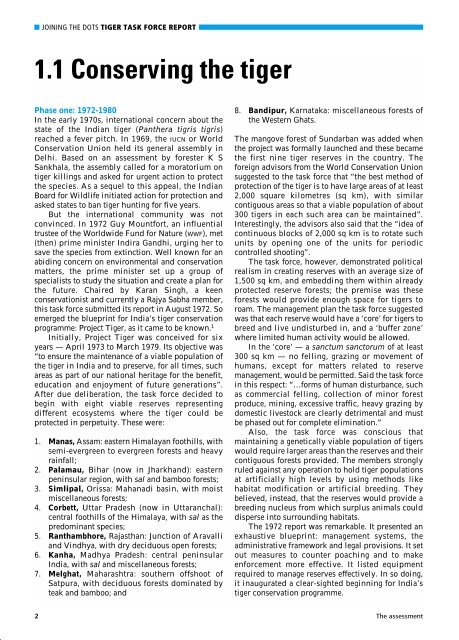Report of the Tiger Task Force - PRS
Report of the Tiger Task Force - PRS
Report of the Tiger Task Force - PRS
You also want an ePaper? Increase the reach of your titles
YUMPU automatically turns print PDFs into web optimized ePapers that Google loves.
■ JOINING THE DOTS TIGER TASK FORCE REPORT1.1 Conserving <strong>the</strong> tigerPhase one: 1972-1980In <strong>the</strong> early 1970s, international concern about <strong>the</strong>state <strong>of</strong> <strong>the</strong> Indian tiger (Pan<strong>the</strong>ra tigris tigris)reached a fever pitch. In 1969, <strong>the</strong> IUCN or WorldConservation Union held its general assembly inDelhi. Based on an assessment by forester K SSankhala, <strong>the</strong> assembly called for a moratorium ontiger killings and asked for urgent action to protect<strong>the</strong> species. As a sequel to this appeal, <strong>the</strong> IndianBoard for Wildlife initiated action for protection andasked states to ban tiger hunting for five years.But <strong>the</strong> international community was notconvinced. In 1972 Guy Mountfort, an influentialtrustee <strong>of</strong> <strong>the</strong> Worldwide Fund for Nature (WWF), met(<strong>the</strong>n) prime minister Indira Gandhi, urging her tosave <strong>the</strong> species from extinction. Well known for anabiding concern on environmental and conservationmatters, <strong>the</strong> prime minister set up a group <strong>of</strong>specialists to study <strong>the</strong> situation and create a plan for<strong>the</strong> future. Chaired by Karan Singh, a keenconservationist and currently a Rajya Sabha member,this task force submitted its report in August 1972. Soemerged <strong>the</strong> blueprint for India’s tiger conservationprogramme: Project <strong>Tiger</strong>, as it came to be known. 1Initially, Project <strong>Tiger</strong> was conceived for sixyears — April 1973 to March 1979. Its objective was“to ensure <strong>the</strong> maintenance <strong>of</strong> a viable population <strong>of</strong><strong>the</strong> tiger in India and to preserve, for all times, suchareas as part <strong>of</strong> our national heritage for <strong>the</strong> benefit,education and enjoyment <strong>of</strong> future generations”.After due deliberation, <strong>the</strong> task force decided tobegin with eight viable reserves representingdifferent ecosystems where <strong>the</strong> tiger could beprotected in perpetuity. These were:1. Manas, Assam: eastern Himalayan foothills, withsemi-evergreen to evergreen forests and heavyrainfall;2. Palamau, Bihar (now in Jharkhand): easternpeninsular region, with sal and bamboo forests;3. Simlipal, Orissa: Mahanadi basin, with moistmiscellaneous forests;4. Corbett, Uttar Pradesh (now in Uttaranchal):central foothills <strong>of</strong> <strong>the</strong> Himalaya, with sal as <strong>the</strong>predominant species;5. Ranthambhore, Rajasthan: Junction <strong>of</strong> Aravalliand Vindhya, with dry deciduous open forests;6. Kanha, Madhya Pradesh: central peninsularIndia, with sal and miscellaneous forests;7. Melghat, Maharashtra: sou<strong>the</strong>rn <strong>of</strong>fshoot <strong>of</strong>Satpura, with deciduous forests dominated byteak and bamboo; and8. Bandipur, Karnataka: miscellaneous forests <strong>of</strong><strong>the</strong> Western Ghats.The mangove forest <strong>of</strong> Sundarban was added when<strong>the</strong> project was formally launched and <strong>the</strong>se became<strong>the</strong> first nine tiger reserves in <strong>the</strong> country. Theforeign advisors from <strong>the</strong> World Conservation Unionsuggested to <strong>the</strong> task force that “<strong>the</strong> best method <strong>of</strong>protection <strong>of</strong> <strong>the</strong> tiger is to have large areas <strong>of</strong> at least2,000 square kilometres (sq km), with similarcontiguous areas so that a viable population <strong>of</strong> about300 tigers in each such area can be maintained”.Interestingly, <strong>the</strong> advisors also said that <strong>the</strong> “idea <strong>of</strong>continuous blocks <strong>of</strong> 2,000 sq km is to rotate suchunits by opening one <strong>of</strong> <strong>the</strong> units for periodiccontrolled shooting”.The task force, however, demonstrated politicalrealism in creating reserves with an average size <strong>of</strong>1,500 sq km, and embedding <strong>the</strong>m within alreadyprotected reserve forests; <strong>the</strong> premise was <strong>the</strong>seforests would provide enough space for tigers toroam. The management plan <strong>the</strong> task force suggestedwas that each reserve would have a ‘core’ for tigers tobreed and live undisturbed in, and a ‘buffer zone’where limited human activity would be allowed.In <strong>the</strong> ‘core’ — a sanctum sanctorum <strong>of</strong> at least300 sq km — no felling, grazing or movement <strong>of</strong>humans, except for matters related to reservemanagement, would be permitted. Said <strong>the</strong> task forcein this respect: “…forms <strong>of</strong> human disturbance, suchas commercial felling, collection <strong>of</strong> minor forestproduce, mining, excessive traffic, heavy grazing bydomestic livestock are clearly detrimental and mustbe phased out for complete elimination.”Also, <strong>the</strong> task force was conscious thatmaintaining a genetically viable population <strong>of</strong> tigerswould require larger areas than <strong>the</strong> reserves and <strong>the</strong>ircontiguous forests provided. The members stronglyruled against any operation to hold tiger populationsat artificially high levels by using methods likehabitat modification or artificial breeding. Theybelieved, instead, that <strong>the</strong> reserves would provide abreeding nucleus from which surplus animals coulddisperse into surrounding habitats.The 1972 report was remarkable. It presented anexhaustive blueprint: management systems, <strong>the</strong>administrative framework and legal provisions. It setout measures to counter poaching and to makeenforcement more effective. It listed equipmentrequired to manage reserves effectively. In so doing,it inaugurated a clear-sighted beginning for India’stiger conservation programme.2 The assessment
















